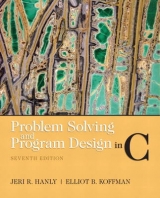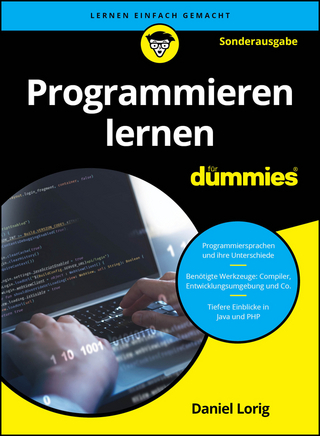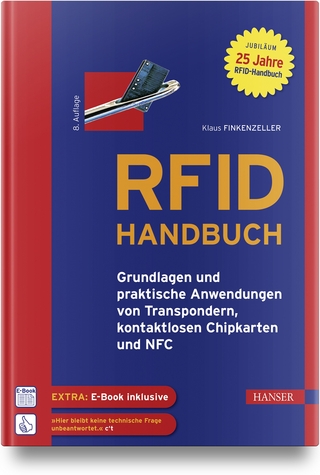
Problem Solving and Program Design in C
Pearson (Verlag)
978-0-321-53542-9 (ISBN)
- Titel erscheint in neuer Auflage
- Artikel merken
Jeri Hanly is Emerita Lecturer in Computer Science at the University of Wyoming. She has also recently been on the faculty of the Computer Science Department at Loyola College in Maryland and Howard University. Elliot Koffman is known around the world as a leader in the field of Computer Science education. Dr. Koffman is a Professor in the Computer and Information Sciences Department at Temple University. He is author or co-author of leading introductory books in most every popular language from FORTRAN through Java. He is also the recipient of the 2009 ACM-SIGCSE award for Outstanding Contribution to Computer Science Education.
CONTENTS
0. Computer Science as a Career Path
0.1 Why CS May be the Right Field for You
0.2 The College Experience: Computer Disciplines and Majors from Which to Choose
0.3 Career Opportunities
1. Overview of Computers and Programming
1.1 Electronic Computers Then and Now
1.2 Computer Hardware
1.3 Computer Software
1.4 The Software Development Method
1.5 Applying the Software Development Method
Case Study: Converting Miles to Kilometers
Chapter Review
2. Overview of C
2.1 C Language Elements 34
2.2 Variable Declarations and Data Types
2.3 Executable Statements
2.4 General Form of a C Program
2.5 Arithmetic Expressions
Case Study: Supermarket Coin Processor
2.6 Formatting Numbers in Program Output
2.7 Interactive Mode, Batch Mode, and Data Files
2.8 Common Programming Errors
Chapter Review
3. Top-Down Design with Functions
3.1 Building Programs from Existing Information
Case Study: Finding the Area and Circumference of a Circle
Case Study: Computing the Weight of a Batch of Flat Washers
3.2 Library Functions
3.3 Top-Down Design and Structure Charts
Case Study: Drawing Simple Diagrams
3.4 Functions without Arguments
3.5 Functions with Input Arguments
3.6 Common Programming Errors
Chapter Review
4. Selection Structures: if and switch Statements
4.1 Control Structures
4.2 Conditions
4.3 The if Statement
4.4 if Statements with Compound Statements
4.5 Decision Steps in Algorithms
Case Study: Water Bill Problem
4.6 More Problem Solving
Case Study: Water Bill with Conservation Requirements
4.7 Nested if Statements and Multiple-Alternative Decisions
4.8 The switch Statement
4.9 Common Programming Errors
Chapter Review
5. Repetition and Loop Statements
5.1 Repetition in Programs
5.2 Counting Loops and the while Statement
5.3 Computing a Sum or a Product in a Loop
5.4 The for Statement
5.5 Conditional Loops
5.6 Loop Design
5.7 Nested Loops
5.8 The do-while Statement and Flag-Controlled Loops
5.9 Problem Solving Illustrated
Case Study: Collecting Area for Solar-Heated House
5.10 How to Debug and Test Programs
5.11 Common Programming Errors
Chapter Review
6. Modular Programming
6.1 Functions with Simple Output Parameters
6.2 Multiple Calls to a Function with Input/Output Parameters
6.3 Scope of Names
6.4 Formal Output Parameters as Actual Arguments
6.5 A Program with Multiple Functions
Case Study: Arithmetic with Common Fractions
6.6 Debugging and Testing a Program System
6.7 Common Programming Errors
Chapter Review
7. Simple Data Types
7.1 Representation and Conversion of Numeric Types
7.2 Representation and Conversion of Type char
7.3 Enumerated Types
7.4 Iterative Approximations
Case Study: Bisection Method for Finding Roots
7.5 Common Programming Errors
Chapter Review
8. Arrays
8.1 Declaring and Referencing Arrays
8.2 Array Subscripts
8.3 Using for Loops for Sequential Access
8.4 Using Array Elements as Function Arguments
8.5 Array Arguments
8.6 Searching and Sorting an Array
8.7 Multidimensional Arrays
8.8 Array Processing Illustrated
Case Study: Summary of Hospital Revenue
8.9 Common Programming Errors
Chapter Review
9. Strings
9.1 String Basics
9.2 String Library Functions: Assignment and Substrings
9.3 Longer Strings: Concatenation and Whole-Line Input
9.4 String Comparison
9.5 Arrays of Pointers
9.6 Character Operations
9.7 String-to-Number and Number-to-String Conversions
9.8 String Processing Illustrated
Case Study: Text Editor
9.9 Common Programming Errors
Chapter Review
10. Recursion
10.1 The Nature of Recursion
10.2 Tracing a Recursive Function
10.3 Recursive Mathematical Functions
10.4 Recursive Functions with Array and String
Parameters
Case Study: Finding Capital Letters in a String
Case Study: Recursive Selection Sort
10.5 Problem Solving with Recursion
Case Study: Operations on Sets
10.6 A Classic Case Study in Recursion: Towers of Hanoi
10.7 Common Programming Errors
Chapter Review
11. Structure and Union Types
11.1 User-Defined Structure Types
11.2 Structure Type Data as Input and Output Parameters
11.3 Functions Whose Result Values Are Structured
11.4 Problem Solving with Structure Types
Case Study: A User-Defined Type for Complex Numbers
11.5 Parallel Arrays and Arrays of Structures
Case Study: Universal Measurement Conversion
11.6 Union Types (Optional)
11.7 Common Programming Errors
Chapter Review
12. Text and Binary File Processing
12.1 Input/Output Files: Review and Further Study
12.2 Binary Files
12.3 Searching a Database
Case Study: Database Inquiry
12.4 Common Programming Errors
Chapter Review
13. Programming in the Large
13.1 Using Abstraction to Manage Complexity
13.2 Personal Libraries: Header Files
13.3 Personal Libraries: Implementation Files
13.4 Storage Classes
13.5 Modifying Functions for Inclusion in a Library
13.6 Conditional Compilation
13.7 Arguments to Function main
13.8 Defining Macros with Parameters
13.9 Common Programming Errors
Chapter Review
14. Dynamic Data Structures
14.1 Pointers
14.2 Dynamic Memory Allocation
14.3 Linked Lists
14.4 Linked List Operators
14.5 Representing a Stack with a Linked List
14.6 Representing a Queue with a Linked List
14.7 Ordered Lists
Case Study: Maintaining an Ordered List of Integers
14.8 Binary Trees
14.9 Common Programming Errors
Chapter Review
15. Multiprocessing Using Processes and Threads
15.1 Multitasking
15.2 Processes
15.3 Interprocess Communications and Pipes
15.4 Threads
15.5 Threads Illustrated
Case Study: The Producer/Consumer Model
15.6 Common Programming Errors
Chapter Review
16. On to C++
16.1 C++ Control Structures, Input/Output, and Functions
16.2 C++ Support for Object-Oriented Programming
Chapter Review
Appendices
A Character Sets
B ANSI C Standard Libraries
C C Operators
D More about Pointers
E ANSI C Reserved Words
Answers
Glossary
Index
| Erscheint lt. Verlag | 24.4.2009 |
|---|---|
| Sprache | englisch |
| Maße | 187 x 232 mm |
| Gewicht | 1330 g |
| Themenwelt | Mathematik / Informatik ► Informatik ► Programmiersprachen / -werkzeuge |
| ISBN-10 | 0-321-53542-1 / 0321535421 |
| ISBN-13 | 978-0-321-53542-9 / 9780321535429 |
| Zustand | Neuware |
| Informationen gemäß Produktsicherheitsverordnung (GPSR) | |
| Haben Sie eine Frage zum Produkt? |
aus dem Bereich



